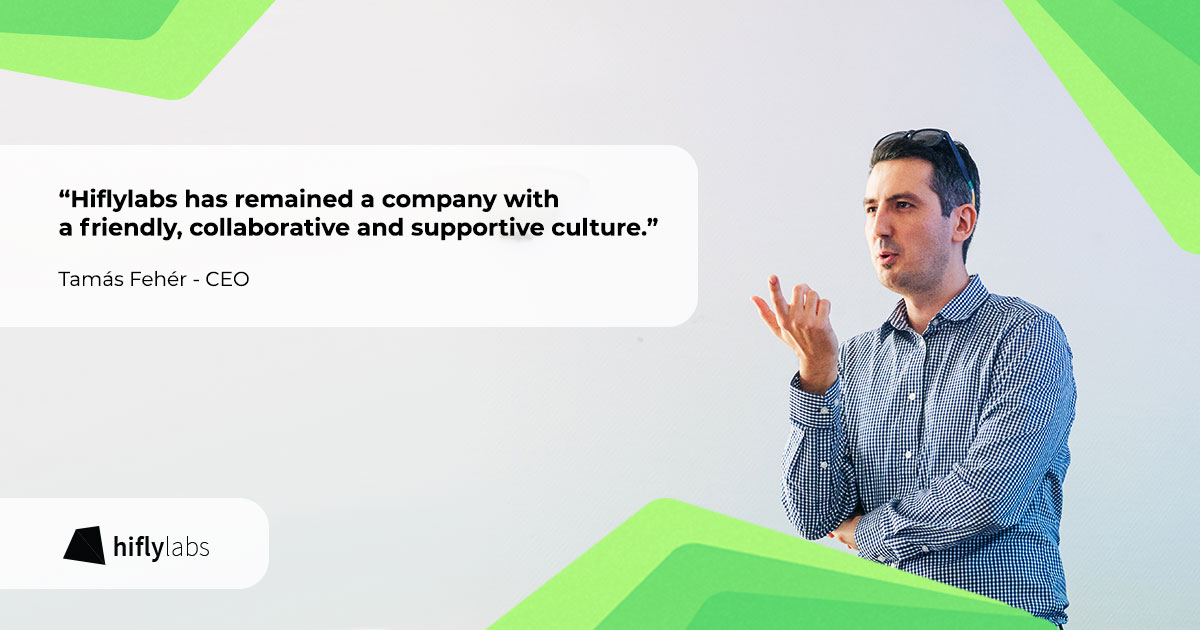Reading time: 4 min

This year we exceeded the number of 100 people. We had a good turnaround, during the pandemic we were able to grow steadily. But even before that, we experienced a significant increase in headcount, in 2017 we were also included in the Deloitte Fast50 list.
From a management point of view, our last 3-4 years have been partly about how we can manage this growth by constantly adjusting internal processes and structures so that colleagues feel that, despite the growth and the resulting change:
– it’s good place to be, because it’s a great and challenging job,
– where they can achieve professional success,
– and, of course, commercially successful.
The management of the company, our aspirations and decisions have been defined and are still defined by these principles in this order. We can say that this is our creed.
We have been implementing these principles, but at least the first two, for many years through a stable, continuously growing and company-wide tree-structured mentoring system, where each colleague has a personal mentor. The mentor constantly monitors the colleagues’ professional, mental well-being and development, and treats when someone is overwhelmed or just getting bored. The mentor escalates upwards when needed and communicates downwards when we see we need to amplify the management’s messages to reach everyone at the company. The favorite words of our mentors are “how are you?” We feel it is extremely important to be able to be aware of whether colleagues are feeling good or bad for private or professional reasons and, if necessary, to give the support we can.
Over the past three years, this ecosystem has been able to handle the doubling of company size, i.e., growing from 50 to 100, and Hiflylabs remains what we love: a friendly, collaborative company with a culture of support.
Of course, in addition to preserving the culture, the normal operation of the company also had to be maintained, and not just to preserve the success of the company. Stuttering operation, bad processes can have a very strong negative effect on the atmosphere. You may never be able to do this well enough, you will always find more and more opportunities to improve. I think it is very important that we always ask our colleagues’ opinion if it is worthwhile. Just a recent example: I find it inconceivable that we’d decide on the issue of home office vs. regular office work – a hot topic for companies in 2020 for sure – without asking our people and taking their say into account as much as possible (even if there are big differences sometimes).
Going back to the processes, functions, and structures, I can say that in the last three years, much has become formalized, refined, transformed, and new processes have grown.
We have moved from an “owners and management do the sales” model to create a dedicated sales team, while of course owners and management continue to do their job. We have a state-of-the-art CRM system and an appropriate reporting structure. We have created an incentive that encourages our trading colleagues not only to maximize profits, and does not compete, but specifically encourages cooperation in line with our three principles.
The “which colleagues are allocated to which projects” problem area, i.e. the planning of resources, has been transformed from “everything in mind” into a systematic process, where projects (of which there are about 25-30 at a time) and colleagues (of which there are 100+ ) is essentially linked in a huge matrix. Our system takes into account trade and market impulses, customer needs, project start and end times, possible delays, as well as the personal preferences, fatigues and motivations of colleagues. It maximizes the utilization of colleagues and tries to consider personal expectations as much as possible (it is possible to say no to a task).
The relationship of delivery competencies has also been clarified in the organization. The team is organized into collaborative business lines, where there is a transition between the areas (also at the level of colleagues and projects), but the boundaries between organizational functions are becoming more and more clear. We knew that a completely flat organization better suited to maintaining a family atmosphere could not be maintained until the end of time. About 2 years ago, with a staff of about 70, we decided to draw a more structured organization, in which a division according to professional competencies had already appeared. We currently have a DWH and data engineering, advanced analytics and data visualization, (primarily mobile and web) application development and consulting business. The latter supports all business lines, with classic business analysts, consultants, PM activities, and also implements consulting projects independently.
As a project company, we raised the role of Project Director and Chief Technology Officer (CTO). Our project manager ensures the systematic implementation of projects. Our CTO and his team do all this from a technology standpoint. Besides, it guards our innovation and, very importantly, monitors – and sometimes determines, both in-house and with our customers – the technological directions of the future.
We consider ourselves to be Hungary’s leading data company, and our mobile / web application development division is growing extremely dynamically (we doubled our volume last year and this year as well). We strive to create value for our clients through our projects while building a workplace with a culture where it’s good to come in and where everyone can be successful professionally, that makes our company successful in business.
Seeing our growth, I was anxious for a long time about how long the company culture, which is so dear to us, and the supportive atmosphere can be maintained. Now I see that this will require a structural change, but with the help of our colleagues who are becoming leaders, we will also be able to pass on our values to a much larger organization.
Author: Tamás Fehér – CEO
